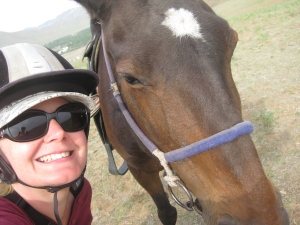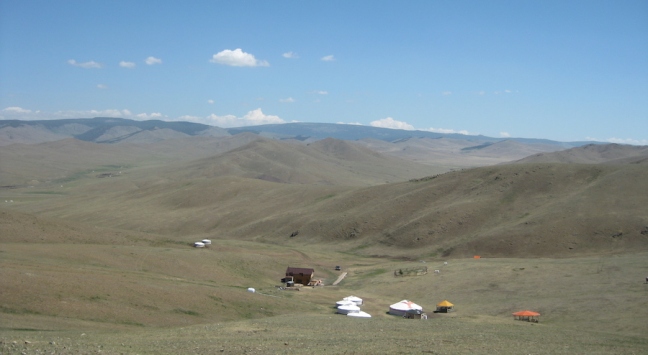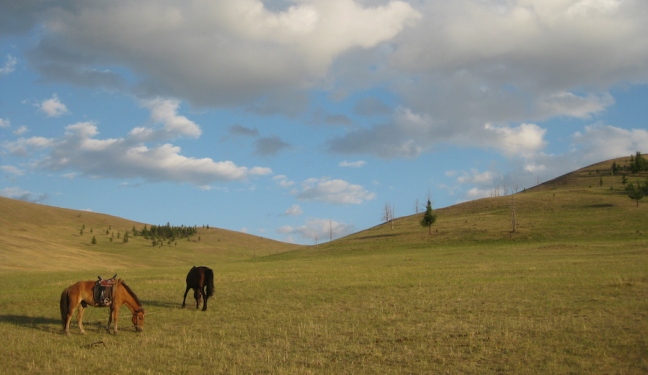 I’m now back from my latest international adventure, the focus of which was a two-week horse trek across the steppes of Mongolia. It was an amazing trip: challenging, inspiring, fascinating. And boy did it go quickly.
I’m now back from my latest international adventure, the focus of which was a two-week horse trek across the steppes of Mongolia. It was an amazing trip: challenging, inspiring, fascinating. And boy did it go quickly.
Over the coming weeks I intend to write a series of posts about my Mongolian experiences. (There’s so much to say I have been struggling to decide where to start!) I think my photos have come out OK — some of them anyway — so stand by for an avalanche of steppes and horses and the occasional selfie…
First up, I’m going to deal with some of the FAQ — everyone so far wants to know how the horse riding went. (How did I pull up? What was the trek like? Did I fall off?) So this first post covers some of the logistics of the expedition.
Stepperiders
We arranged our trek with a local company called Stepperiders, which has around 100 horses. They operate out of their private ger camp (outside Ulaan Baatar), where trekkers hang out both before and after their respective treks. There’s no running water or electricity, but it’s a lovely relaxed environment, providing the opportunity to swap notes with other travellers and to start soaking up the beauty of the steppes.

There’s also ample opportunity to watch their gorgeous horses, either running free in the herd or getting rounded up and singled out for riding. We went for a group ride the afternoon we arrived, possibly so they could assess our ability and decide what horses to assign us for the next fortnight. In any case, I ended up with a different horse the following day.
Mongolian time
We were surprised to discover that our two-week trek would be just the two of us, accompanied by three Stepperiders staff: our “horsewoman”, who determined the route and was responsible for the care of the four horses; our English speaking guide, who looked after the two of us very well indeed; and our driver, who transported all the gear (bags, tents, bedding, cooking equipment etc) via car and met our riding group at intervals with water.
Another surprise was the daily schedule, which comprised late starts and late finishes. Although our lack of timepieces meant we were never sure exactly what the time was, we grew increasingly adept at judging time from the position of the sun. We think we broke camp and rode out each morning sometime around 11:00-11:30am (much later than we expected), stopped for an extended lunch break around 1:30-2:00pm (maybe around 90 minutes?), and finished riding around 7:00pm. (The sun was setting around 10pm.)
For the first few days, I really struggled to make sense of the passing time, which I couldn’t internally account for. Normally I’m not too bad at judging time, but “Mongolian time” is a thing all to itself. Especially when one is on horseback or lazing about on the grass. It slithered and slipped past like a fast-running stream. This was a challenge for me, as I thrive on structure; but I think by the end I was fairly chilled about it all.
My horse
My assigned horse was a dark bay, with a lovely gentle personality. He was dependable, sure-footed (as are just about all Mongolian horses), and never startled (even when other horses got bolshy around him). He did have a tendency to take the slow option, but demonstrated several walking and trotting gears after sufficient encouragement. He could certainly be fast when he wanted, but didn’t seem to want to all that often.

We named him Sir Placid. (The Mongolians don’t name their horses; they refer to them by fairly specific colours and markings.) The other name we called him sometimes was Sir Gasalot.
As the days progressed I got a lot better at asserting my authority, but at heart I know I’m a soft touch and most of the time we were at the back of the party. Nonetheless, I was definitely aware of my confidence and skills improving as the days progressed. Moving with the horse started to become more instinctive, and I felt more as though I were “riding” as opposed to merely sitting on the horse’s back.
To the steppes!
We rode out from the Stepperiders camp that first sunny afternoon and made our way across the undulating landscape to our first campsite in Bogd Khan National Park. Over the next several days we visited Manzushir Monastry, Terelj NP and the massive 40-metre statue that is the Chinggis Khaan monument… but the majority of our time was spent riding across the vast and beautiful steppes.

The steppes, to my surprise, are not flat. At least, not the region surrounding UB, where we were riding. They comprise hills and mountains and broad valleys between. We rode up and over and around many grassy hills, often strewn with rocks.
The horses walked whenever we were doing something precarious — such as traverse or descend a steep hill — or where the ground was especially rocky. (We took those horses up and down slopes I could never have predicted.) Other times the horses rather liked to trot and, at times, canter. We didn’t gallop a lot, especially in the second week, but there were some occasions early on when we flew across the valley floor.
Surviving two weeks on horseback
I am pleased to report that I managed two weeks on horseback pretty well. I expected to have sore muscles, at least at first, but that didn’t actually happen. Whether it was my Pilates preparation, or a characteristic of the horses (which are fairly narrow shouldered and have a smooth gait) — or a combination of the two — I’m not sure. But every morning I awoke feeling fresh and not at all stiff or sore. Getting on that horse again each morning was easy.
I did get fatigued, though, particularly as the trek went on. At the end of the day, it was harder to lift my leg over the horse’s back, and my knees ached after hours in the saddle. In the second week it was worse, but easily relieved by dismounting and walking around for 5 minutes. A couple of times I walked alongside the horse for 5 minutes or so, just to stretch out my knees.
I got tired if we did too much trotting too. We rather enjoyed trying the Mongolian style of riding, which is to stand in the stirrups when trotting and cantering. Initially, I could manage about three beats in the trot (essentially a slow-motion rise and fall), but built this up to longer as the days progressed. It did take it out of my body, though, and at the end of each day trotting was really hard.
It’s much easier, however, to stand for cantering and galloping. At such times, when I found my optimum balance, it was like flying as the horse moved under me. Wonderful.
And, no, I did not fall off. Huzzah!
I think that’s enough for the first installment. More later… Promise.
In the meantime, last week I posted a short 30s video entitled ‘A glimpse of Mongolia‘, which I filmed at the end of Day 9 of the trek. You can meet my horse there too.
You’re probably going to get tired of hearing variations of “what an amazing experience” from me, but wow. What an amazing experience! And I want to hear about all of it!
LikeLiked by 1 person
Well, I’ve just identified at least six more posts… You’ll probably get tired of hearing about it. I will have to drip feed… 😉
LikeLiked by 1 person
I am VERY interested to hear anything you want to share about your Mongolian holiday. I’ve been fascinated by the landscape of the country since college. Visiting it is one of my “this is out of my comfort zone” items on my bucket list.
How much riding experience did you have prior to this trip, Ellen?
LikeLiked by 1 person
Hi Rabia – it’s nice to hear from you. I think you should put Mongolia up a few notches on the bucket list. It’s amazing. Yes, there are some challenges, especially with the camping angle, but it’s all worth it.
As for riding experience, I had very little. I had been on a horse several times in the past, but infrequently and never for more than a two or three hour trail ride. I had cantered and trotted a little, but mostly walked.
So you can definitely do this without much (if any) riding experience at all… you just learn as you go. I did do some physical conditioning via Pilates beforehand though, which I think helped a lot with my balance and strength.
LikeLike
So far it sounds like you had a very awesome time…and Sir Placid looks like a mighty steed 🙂
LikeLiked by 1 person
He was mighty indeed!
LikeLiked by 1 person